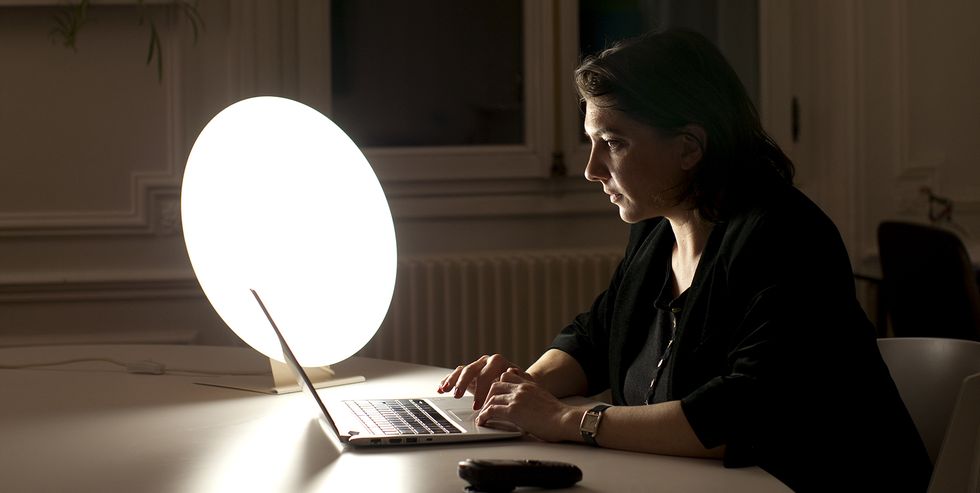==================
A Caveat and Affiliates
First off, a little caveat: within my articles you will find affiliate links, meaning if you buy them, I get a small commission. Your cost is not affected. In addition, I am an Amazon Associate and I earn from qualifying purchases on Amazon.
And yes, if I say that I recommend a product here, it means I truly believe it is a good product. I refuse to recommend any product that I have not researched and believe to be a good value.
Even better, I provide you with a very clear picture of the product, it’s use, and the probable value.
Earning your trust is important to me. I run this website myself and the commissions and donations help support the site.
Sound reasonable and fair enough? Let’s continue to the article.
==================
Sun lamps are artificial lights specialized in mimicking natural sunlight. Study shows that sun lamp therapy helps brighten mood disorders. These lights are also said to improve our bodies’ vitamin D production, helping them to run smoothly. Here’s more about sun lamps winter uses, tips for using them, and how to select the best one that suits your home office needs.
Contents
Sun Lamps Winter Uses
Besides being called a SAD lamp, a sunlamp is also referred to as a light therapy box. Light therapy or bright light therapy is the treatment for seasonal affective disorder (SAD) as well as other disorders such as sleep disorders and dementia.
Sun Lamps for SAD
Sun lamps winter uses commonly include treating a seasonal affective disorder or SAD—the reason why sun lamps are mostly addressed as SAD lamps. Around 6% of the U.S. population experience SAD. Whereas 14% of adults in the United States deal with a minor form known as the winter blues. As its name implies, SAD is a type of seasonal depression that happens during the fall and winter when there are shorter days and less sunlight. Symptoms of this mood disorder often include lack of energy, trouble sleeping, difficulty concentrating, and oversleeping during cold seasons—mostly winter, but can also occur during summer months. Aside from SAD, winter also brings morning blues, depression, lethargy, insomnia, and confusion.
The time you should spend in front of a sunlamp depends on the intensity, and there are different intensities available. It will also base on the model you pick up and how bright it gets. (No two lamps are exactly alike; each may have different directions and durations of use.) Here’s how to use a SAD lamp for the best results:
- Put your desktop sunlamp 70 cm far from your face.
- The sunlamp should be positioned 30 degrees overhead.
- Avoid looking directly at the light as it can irritate the eyes.
- Manufacturers and doctors recommend up to 30 minutes of direct exposure.
- Try to use the sunlamp at the same time every day.
For Sleep Disorders

Sleep disorders due to the disruption of our bodies’ circadian rhythm or internal body clock are also common in winter. Disruption in our bodies’ internal body clock can cause insomnia and extreme fatigue, as well as interfere with our ability to function. Physicians believe artificial lights from sun lamps are great for resetting and improving our circadian rhythm in times when our body struggles due to oscillations of natural lights.
Sun lamps winter uses also have a positive impact on serotonin and melatonin—chemicals responsible for controlling the sleep and wake cycle. Increasing serotonin will help reduce anxiety and improve mood while reducing melatonin keeps our bodies from feeling sluggish. Researchers even found that light therapy, with or without an antidepressant, has better results in combating depression symptoms compared to the placebo.
Light Therapy and Dementia
Though a sun lamp is mostly used for SAD, it can also be used for treating other conditions, including dementia. Dementia and Alzheimer’s patients commonly suffer from behavioral issues like agitation and depression that root in an abnormal sleep cycle. Light therapy may improve these symptoms. Studies have found that light therapy used in care homes has shown a reduction in agitation, night wandering, and low moods with effects lasting for a long while. Whereas insufficient exposure to intense daylight can negatively impact the health and well-being of dementia patients.
Sun Lamps Winter Uses—prescriptions
The sun lamp’s light therapy might sound new, but in truth, light therapy has existed long in history. As a matter of fact, doctors have long been recommending this therapy for various ailments. For instance, some physicians prescribe that a person experiencing SAD should sit by a lightbox with ten thousand lux (lux refers to the lamp’s luminance level) for 30 minutes each day right after waking up to increase energy levels to start the day and to help promote better sleep at night.
Existing evidence supporting the benefits of light therapy is available, though there is a lack of recent research on this topic. However, this type of therapy is not for everyone. Individuals with light sensitivity, diabetes, bipolar disorder, and eye problems should avoid this kind of treatment. Additionally, experts advise using only SAD lamps that emit fluorescent light having no added UV wavelengths, to avoid damaging the skin which can lead to skin cancer.
That being said, UVB light is essential for the skin to the skin produce vitamin D. With this, anyone considering using a SAD lamp should first consult a healthcare professional.
Desktop Sunlamp

Along with sun lamps’ winter usage, they are also great for office space. Desktop sunlamp will illuminate powerful light onto your office space. Installing desktop sunlamps does not require professional assistance and you can purchase one for work purposes. Several types of sun lamps are available online, thus, it’s crucial to consider the best one that suits your needs. The following are simple tips on choosing the best desktop sunlamp for your home office.
Tip 1: Find a lamp that emits white color rather than those that give off red or yellow light. The lesser the wattage of bulbs, the better. Avoid cheaper bulbs that contain tungsten filaments. Bulbs with tungsten filaments emit heat and ultraviolet light which are least efficient and harsh to glare.
Tip 2: When working at a computer, makes sure that you are doing your work in front of a desktop sunlamp. Also, the ideal time for using sun lamps is 6-to-8 hours a day which fits perfectly for working hours. Using a sleep timer will help get the best out during these hours, as well as allow you to ensure that you have not left a light on.
Misconception & Health Risks
Note that a SAD lamp or Desktop sunlamp should not be confused with sun lamps used for tanning and treating skin disorders. Desktop sunlamps and SAD lamps do not and should not emit ultraviolet light to avoid damaging your eyes. Meaning these types of sun lamps will not give you a tan or increase your vitamin D levels. Possible side effects of having the wrong type of sunlamp include:
- headache
- eyestrain
- nausea
You can manage these side effects by increasing your distance away from the sunlamp or reducing the time spent in front of it. People with certain illnesses like macular degeneration, lupus, connective tissue disorders, and bipolar disorder should avoid using light therapy boxes to not worsen their conditions.
How to Choose the Best Desktop Sunlamp for Home Office
Checking the legitimacy of a product’s specifications and health claims is important before buying. That being said, you’ll need a desktop sunlamp having a luminosity of at least ten thousand lux with UV-blocking capabilities. Here are other important factors to consider:
Lens – Desktop sunlamp lenses should have built-in UV-blocking technologies to filter out harmful rays that you don’t need.
Adjustability – You should be able to adjust the angle of the SAD lamp downward to reduce luminescence. Interestingly, a recent study found that short-term use of multidirectional surface lamps induces no significant effects on core temperature, blood pressure, plasma melatonin, and salivary cortisol of people who rarely use them.
Efficiency – Consider how energy-efficient a SAD lamp is and how much it would cost to buy new bulbs if required. Some SAD lamps use replaceable bulbs, while others use LED lights that can last for over 5 years. Also, consider how large the coverage area of the desktop sunlamp light is. A larger coverage is preferable since it requires minimal distance to cover specific areas of your body. Some lamps that claim to have cold light might actually still be very hot.
Sun Lamp Winter Summary
In a nutshell, desktop sunlamps have a variety of benefits however, individuals should be careful when using these devices. It is important to remember that light therapy is not recommended for everyone. All in all, you can effectively utilize sun lamps winter benefits to your advantage especially in keeping you on the go for your remote work.
Related Articles



